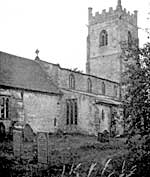
Cropwell Bishop.
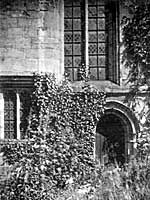
Barton-in-Fabis.
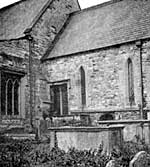
South Muskham.
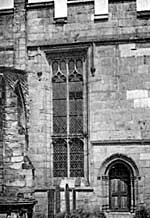
Wilford.
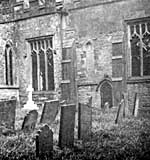
Kneesall.
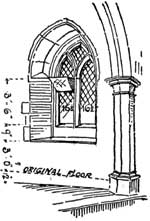
West Leake.
Cropwell Bishop (St. Giles). Parts of the church, built of Blue Lias limestone, are in a perishing condition. South wall of chancel rebuilt. North wall original, contains an ancient "low side window" at 18in. from the west end, 14in. wide, 1ft. 11 in. high, 3ft. from ground to cill, finished with a (modern) ogee head with cuspings, cut out of a single stone. Probably the original head was a plain lancet; if so, this window would correspond in every respect with the windows in north aisle. Internally there is a flat cill and wide equal splays, but no rebate or trace of a shutter. The chancel arch is plain, with continuous chamfers; the jambs have no intervening cap mouldings. In my opinion this window was intended to give light beneath the rood-loft. The village lies to the south and west.
Oxton (St. Peter and St. Paul, or St. Peter). At the west end of chancel on south side there is a plain square window, divided by a chamfered mullion into two lights, each 14in. wide, 4ft. high, 3ft. lin. from floor to flat cill, 18in. higher to glass line, wide splays at sides and soffit. The window, which is a later insertion in an ancient wall, is now glazed and retains no trace of ever having served any other purpose than to give light beneath a rood-loft.
Barton-in-Fabis (St. George). A two-light window at the west end of chancel on south side, each light 12in. wide, 4ft. high to springing, cusped heads. It is only necessary to look at the fenestration to conclude that this window was intended to light the reader's desk. The splays are equal, recessed in two orders—a wave moulding and a chamfer—both on the inside and outside.
South Muskham (St. Wilfrid). A large Early English chancel, lighted by three tall narrow lancets on either side, having cills high up above floor level, and a priest's door beneath the drip moulding on the north side. At the west end on the south side a two-light window has been inserted at a later date, evidently to give more light on the reader's desk.
Wilford (St. Wilfrid). A beautiful two-light window at west end of chancel on south side, each light 24in. wide, 5ft. from ground to cill, which is "low" only because the eastern window cill is high to pass the sedilia. Jambs beautifully moulded inside and outside. This window may be taken as a development of the converted windows of a former period, and was never intended for any other purpose than to give light. Dial markings on buttress E. side of chancel door.
Kneesall (St. Bartholomew, or St. Helen). Originally this E. English chancel was lighted by two narrow lancets on either side. At a later date it was extended eastwards, and two three-light windows were introduced in the south wall, the cill of the western window being brought down to a lower level than the eastern one, obviously to obtain more light at this point. The old lancets, built up and dispensed with as windows, may still be seen in the outer wall.
East Leake (St. Helen, or St. Mary). The same treatment is noticed here, save that the western window is composed of three lancets under a hood mould, having the internal splay to westward only and a square reveal on the other side, and the eastern one is a two-light Decorated window, with reticulated tracery.
West Leake (St. Leonard, or St. Helen). A plain two-light window, without cusp-ings, has been inserted at the west end of the south wall of chancel, each light 16½in. wide, 3½ft. high to springing, 3ft. from original floor level to cill (present floor is 12in. lower). No trace of shutter rebate. Unequal splays, wider on west than east. The surrounding walling is older than the window and slightly thinner, being recessed about l½in. on the exterior all round the opening.
The eastern window on this side is a two-light Decorated window with reticulated tracery. On the north side there is a window to correspond, and also a blocked-up doorway, shewing on the outside only. The village is small and scattered. No houses on the south side.
Sutton Bonington (St. Anne). A neighbouring church, treated in a similar manner. There can be no doubt that this window, removed from the east end, was re-fixed here to give more light in this particular part of a poorly-lighted chancel.
Sutton Bonington (St. Michael). This chancel has been rebuilt. There are four stone panels, two on either side, at cill level, 16in. by 14in. Each panel is pierced with two narrow cusped openings, and connected by a cavity in the thickness of the wall with similar panels, at a higher level opening into the chancel. These were intended to be ventilators, but whether there was any precedent for the design in the old work I have not been able to ascertain. They are similar in design to "low side" openings in other parts of the country.
Balderton (St. Giles). The south wall of chancel originally contained three lancets and a priest's door. In place of the central lancet a large three-light Perpendicular window has been inserted, the cill being brought down to a lower level to give more light.
Normanton-on-Trent (variously given as St. Matthew, St. Mary, or St. Nicholas). The same thing happened here, save that the inserted window is a two-light Decorated one. Chancel rebuilt.
Laneham (St. Peter). The chancel walls contain much "herring-bone" masonry. In place of the small Early English window, a three-light Perpendicular window was introduced in the south wall, and later still a large two-light window of debased type was introduced at the west end of the south wall, obviously for light.
Plumtree (St. Mary). The south wall of chancel may be taken as a type of numerous churches, built in the Perpendicular period (or rebuilt later still), having the cill of the western window at a lower level than the eastern, either on account of the sedilia or with the object of giving light upon the reader's desk. The following have been noticed: Clifton, Gotham, Thrumpton, Bingham, Walesby, Beckingham, Hay-ton, Bleasby, Egmanton, North Collingham, Wysall.
Class C.
The following examples, all said to be "leper windows," are included to complete the survey, but they are not to be classed as " low side windows" at all.
Hucknall Torkard (St. Mary Magdalene). This church has been enlarged and modernised until almost every trace of the ancient parish church has been obliterated. At the east end of north aisle, 6ft. from transept wall, are traces of an opening, approximately 3ft. wide, 2ft. high, 3ft. above floor level, now built up with masonry and all trace of its former use obliterated. The ancient village lay to north and east.
Stapleford (St. Helen). An Early English window in the usual position has been clumsily restored, and all identity lost. " Dial markings" on the wall of south aisle.
Edingley (St. Giles). This is but a fragment of what was once a fairly large village church. The south arcade of nave and chancel is built up with masonry and is now external. On the south side of chancel, in the blocked-up archway, there is a doorway and a two-light window, the work of a late period, and having no significance. Cill blocked with masonry and plastered inside.
Wollaton (St. Leonard). A Tudor aisle and organ chamber on the north side. There is a small doorway and a peculiar low window beside it, but this was made to give light in the organ chamber.
Selston (St. Helen). Beneath the cill of the east window there is a recess in the external wall 13in. wide, 17in. high, 10in. deep, back to front, 4½ft. from ground to cill, plain chamfer all round. This was evidently made at a later date. Its purpose may have been to contain a picture, painted on glass, and placed so as to be seen above the altar from within, when illuminated by a lamp placed behind it. There is a similar recess, known to have been made for this purpose, at Hickling.
Cromwell (St. Giles). On the north side of chancel there is a blocked doorway, and beside it the remains of an aumbry in the wall. These conditions indicate that the door once gave entrance to a vestry now destroyed.
Class D.
Squints in the respond of chancel arch at Finningley, Harworth, Nuthall, Upton, Rampton, Everton (plastered over), Linby (plastered over), Burton Joyce, Kelham. On north side, from vestry to altar, at Hawton and Lambley.
With the exception of those elsewhere acknowledged, all the illustrations in this paper have been supplied by the writer.
